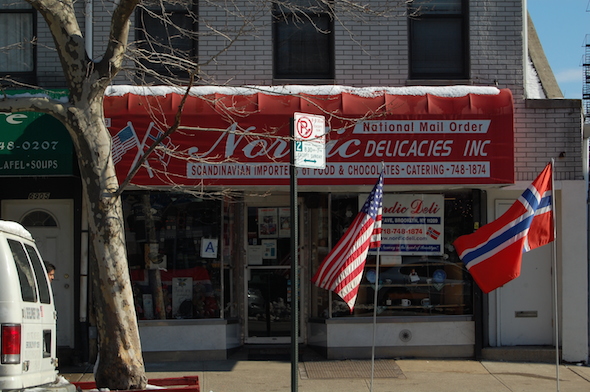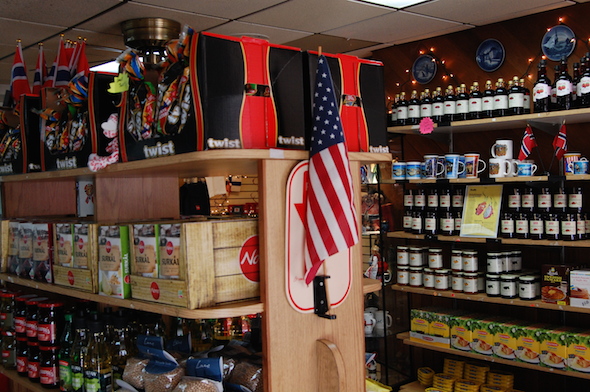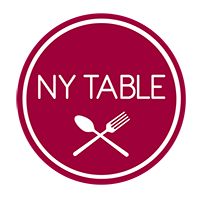Nordic Delicacies, a Thin Thread to a Lost Legacy
By Marie-Jose Daoud
On 3rd Avenue in Bay Ridge, Brooklyn, a small shop stuck in between a large Mediterranean deli and an abandoned patch of land stands out: there are colorful wool sweaters in the left window, embroideries and plates in the right window, and a big Norwegian flag next to the American one planted on the right side of the sidewalk. On the glass door of the shop, there is a white piece of paper with today’s typed menu: Roast beef dinner-$7.50, Lapskaus-Beef Stew-$7.50, Pasta with meat sauce-$7.50, Komper-$5.00.

Nordic Delicacies is the last remaining Scandinavian store in Bay Ridge, Brooklyn. Photo: Marie-Jose Daoud.
Nordic Delicacies is the last remaining Scandinavian deli in Bay Ridge.The neighborhood was home in the 1950s and 1960s to more than 250,000 Scandinavians, the largest concentration in the United States. Today, very few remain. Five blocks away, Eighth Avenue used to be called Lapskaus Boulevard, after a Nordic stew made of meat and vegetables, often leftovers, that were diced together and slowly boiled. Twenty years ago, the street was rechristened Little Hong Kong, testimony to the large Chinese community that settled in.
Arlene Rutuelo and her mother Helen Bakke opened the shop in 1987, at a time when Scandinavians had already deserted the area. “In the early 80s some of the main Scandinavian stores had started to close, there were probably one or two other than us still in business then,” said Rutuelo. “This is when we felt, you know, it’s either let everything die or we take it upon ourselves to continue the tradition. “
Rutuelo is a 5’7’’ tall woman who’s turning 50 in June. She carries herself with a no-nonsense attitude, and even her short blond hair conveys an idea of practicality. She hardly ever holds still; juggling between the kitchen and the counter, cooking fish cakes, salmon, waffles, laspskaus, running the place from 9:00 a. m. to 6:00 p. m. five days a week, and until 3:00 on Saturday.
She was born in Bay Ridge to Nordic parents who emigrated in 1958 from their small town in the mountains of Norway. Her father was a carpenter; her mother was a housekeeper at the nearby Norwegian Christian nursing home. She grew up accustomed to her mother’s homemade food. “We always had traditional Norwegian Christmas and holidays so I was very familiar with what we are preparing here in the shop,” she says.
Scandinavian cuisine revolves around fish (smoked salmon being a major source of export), pork meat, potatoes, root vegetables and cabbage. “Our food is pretty much organic and healthy,” says Rutuelo.

Arlene Rutuelo and her mother Helen Bakke stand behind the counter of Nordic Delicacies, the Scandinavian store they have managed since 1987. Photo: Marie-Jose Daoud.
When she graduated from Ford Hamilton High School in Bay Ridge, she worked as a nurse’s aid and in the kitchen at the Norwegian Christian nursing home.But the arrival of a daughter named Danielle, when Rutuelo was in her early twenties, pushed the family to think about a way to avoid putting the little girl in day care. This is when the idea of the shop came along: “ I was young and excited about it, “ says Rutuelo, “it might not have been my dream per se, but this place is family. And 28 years later, I am still having fun.”
Most of the shop’s customers are regulars who come in to pick up the homemade food of the day and groceries imported from Norway, which are displayed on the shelves and in the store’s refrigerators. Helen Bakke, a short blond 74-year-old who carries herself in a very similar way to her daughter entertains customers from behind the counter, or even invites them back there for a coffee and a chat.“Sometimes, I get out of the kitchen and I find every seat of the place occupied by people chatting and talking away around a cup of coffee,” said Rutuelo. There is a small table with two chairs for people to sit and rest near the right side window, as well as a leather chair and stools behind the large counter, and additional ones can be put in front of the counter to accommodate more people.
Solveig Simonsen McLoughin, a tall, thin and very sociable woman in her 50s who lives in Brooklyn, has been coming here since the store opened. Born in a fishing village in Norway, she came to the States when she was nine years old, married an Irish-Swedish man and had three children, all of whom have moved out of the neighborhood.“I love coming here,” she says. “All is homemade. It’s like eating at your mother or grandmother’s home.”
On a recent visit she bought meatballs, Lingonberry jelly , and canned fish. “They do a excellent fish cake in here,”she says, referring to a croquette-like mixture of cod fish and potato. The waffles (very similar to the Belgian ones) and the Kransekake (a holiday cake made up of egg whites and almonds rings piled on top of each other and held together by icing) are regular favorites.
Rutuelo says that she cooks on average around 50 meals to go each day, apart from the regular items on the menu, and has two to three people in the kitchen to help her. For the Christmas holidays and the May 17 Norwegian Parade, around 15 of her family members and friends come and give her a hand.
While she is part of neighborhood business association, her interactions with the nearby Chinese and Mediterranean food stores, though cordial, are limited. By her own admission, she prefers to eat the food she prepares.
One part of Nordic Delicacies’ business that’s on the rise, as the only Scandinavian deli on the East Coast, is mail order. The shop ships Scandinavian food and gifts all over the States, to Scandinavians who miss the food from their childhood. “They are not so much missing the food per se,” explains Rutuelo, “but it is the connection to the place where their parents came from and the experience, I think.”

The store caters to all Scandinavian tastes. Rows of Lingonberry jelly, fish oil, Swedish pancakes, Scandinavian chocolates compete for space with teddy bears, national flags and Nordic sweaters. Photo: Marie-Jose Daoud.
Every time McLoughin visits her children, she brings some Norwegian food. “They always ask for the Nordic rice pudding [both a dinner and dessert dish], if I don’t bring it with me, I am not allowed to enter their house,” she says.
Before leaving, Simonsen offered a scarf that she had knit herself to Gloria, a long-time regular customer and friend who helps during the rush season and was was chatting peacefully with Bakke behind the counter. The greenish scarf had the trademark home-made uneven stitches that made it so welcoming. Simonsen, who knits as a pastime, even went back to her car and brought in another scarf for Rutuelo.
Over the last few years, new Scandinavian-inspired restaurants have opened in Williamsburg and other areas of Brooklyn, surfing the health-conscious and organic food wave. The movement started with the opening of Noma in 2003, and has been dubbed “New Nordic.” But Scandinavian chefs in New York had to bend their dishes to adjust it to the American palate: it can be pretty hard to convince a New Yorker to taste blood pudding, a favorite in Sweden. “Whatever brings awareness to the Norwegian culture is a good thing,” comments Rutuelo, “They have to meet the diverse cultures where they are. It’s marketing. I say bravo to them.”
She sells some Italian bread and Parmesan in her shop, to attract customers who would not otherwise enter the shop. “Sometimes, I make lasagna,” she says.
Rutuelo’s three children, two sons and one daughter, grew up running around in the shop. They all know how to cook Norwegian food: “A love of food and a love of cooking has been transferred, which is good ,” she said. Her daughter helps her regularly in the shop, the two sons only on occasion. One of them is an engineer, and the other is currently looking for a job in retail. Rutuelo says that she doesn’t want them to be bound to the shop, she wants them to find their own path: “Whether Nordic Delicacies lives on for 50 more years or if it dies with our generation, I am OK with either way of that,” she says.
Tags: Bay Ridge, Nordic cuisine, Scandinavian cuisine

My aunt and cousins are Norwegian, my husband 1/2 Swede. Arlene and her mama and family are fantastic! Kudos for their dedication and steadfastness to Scandinavian culture in our (old and new) neighborhoods! Tusen Takk – keep it going!